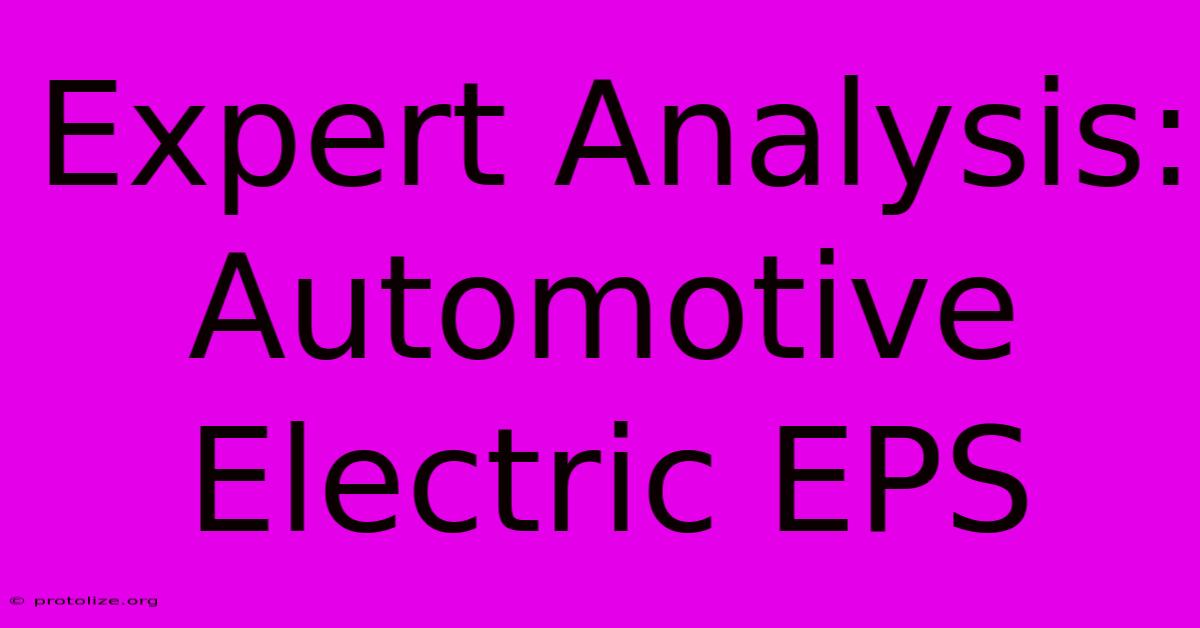Expert Analysis: Automotive Electric EPS

Discover more detailed and exciting information on our website. Click the link below to start your adventure: Visit Best Website mr.cleine.com. Don't miss out!
Table of Contents
Expert Analysis: Automotive Electric EPS
The automotive industry is undergoing a dramatic transformation, driven by the increasing demand for electric vehicles (EVs) and advanced driver-assistance systems (ADAS). At the heart of this revolution lies the electric power steering (EPS) system, a crucial component impacting both vehicle performance and driver experience. This expert analysis delves into the intricacies of automotive electric EPS, exploring its advancements, challenges, and future prospects.
Understanding Electric Power Steering (EPS)
Traditional hydraulic power steering systems are being rapidly replaced by EPS, primarily due to their enhanced efficiency and integration capabilities. EPS systems utilize electric motors to assist the driver in steering, offering several key advantages:
- Improved Fuel Efficiency: Unlike hydraulic systems that constantly consume engine power, EPS only operates when steering assistance is needed, resulting in significant fuel savings, especially critical for EVs.
- Enhanced Integration with ADAS: EPS systems seamlessly integrate with ADAS features such as lane keeping assist and autonomous driving, providing precise and responsive steering control.
- Reduced Mechanical Complexity: EPS systems have fewer components than hydraulic systems, leading to simplified vehicle design, reduced weight, and enhanced reliability.
- Greater Customization: EPS systems allow for precise control and customization of steering feel and response, tailoring the driving experience to different vehicle types and driver preferences.
Types of Electric Power Steering Systems
Several types of EPS systems exist, each with its own characteristics and applications:
- Column-Assist EPS: The motor is mounted directly on the steering column. This is a cost-effective solution, ideal for smaller vehicles and simpler applications.
- Pinion-Assist EPS: The motor is located near the steering rack, providing greater steering torque and responsiveness. This type is common in larger vehicles and those with advanced ADAS features.
- Rack-Assist EPS: The motor is integrated directly into the steering rack, offering excellent efficiency and precise control. This is often found in high-performance vehicles and those with sophisticated autonomous driving capabilities.
Advancements in Automotive Electric EPS Technology
Continuous advancements in EPS technology are driving further improvements in vehicle performance and safety:
- Advanced Motor Control Algorithms: Sophisticated algorithms optimize motor torque and response, ensuring precise steering feel and minimizing energy consumption.
- Sensor Integration: EPS systems rely on a network of sensors (e.g., steering angle sensor, torque sensor, speed sensor) to provide real-time feedback and adjust steering assistance accordingly. Improved sensor accuracy and integration contribute to enhanced safety and performance.
- Haptic Feedback Systems: These systems provide the driver with tactile feedback through the steering wheel, enhancing the driving experience and providing crucial information in certain driving conditions.
Challenges and Future Trends in Electric EPS
Despite its advantages, the widespread adoption of EPS faces certain challenges:
- Cost: While costs have decreased, EPS systems can still be more expensive than traditional hydraulic systems, particularly advanced systems with sophisticated features.
- Durability and Reliability: Ensuring the long-term durability and reliability of EPS systems, especially in harsh environments, remains a key challenge.
- Cybersecurity: As EPS systems become increasingly connected, cybersecurity becomes a critical concern, requiring robust security measures to prevent malicious attacks.
The future of automotive electric EPS is bright, with several exciting trends emerging:
- Increased Integration with Autonomous Driving: EPS will play a vital role in fully autonomous vehicles, providing precise and reliable steering control.
- Enhanced Driver Assistance Features: Future EPS systems will support a wider range of driver assistance features, improving safety and convenience.
- Improved Energy Efficiency: Ongoing advancements in motor technology and control algorithms will further enhance the energy efficiency of EPS systems.
- Wireless EPS: Research is underway into wireless EPS systems, which could offer greater design flexibility and reduced complexity.
Conclusion: The Cornerstone of Automotive Innovation
Electric power steering is no longer just a component; it’s a critical enabler of the automotive industry's transition towards electric and autonomous vehicles. Continuous innovation in EPS technology is essential to meeting the evolving demands for enhanced safety, efficiency, and driver experience. The advancements discussed here illustrate the pivotal role of electric EPS in shaping the future of the automotive landscape. As technology continues to evolve, we can expect even more sophisticated and integrated EPS systems to emerge, paving the way for a safer and more enjoyable driving experience.

Thank you for visiting our website wich cover about Expert Analysis: Automotive Electric EPS. We hope the information provided has been useful to you. Feel free to contact us if you have any questions or need further assistance. See you next time and dont miss to bookmark.
Featured Posts
-
Nba Cup Winner Prediction Emirates
Dec 11, 2024
-
Santa Claus Post Office All Year
Dec 11, 2024
-
Crm Fuer Freiberufler
Dec 11, 2024
-
Fox And Kelly Relationship Ends
Dec 11, 2024
-
Crm Cms
Dec 11, 2024
